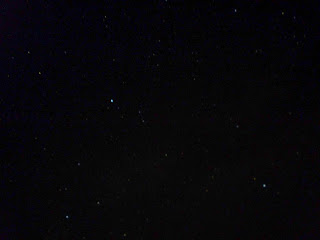LYRIDS METEOR SHOWER AND SKY OBSERVATION

We planned to watch the Lyrids Meteor Shower on 22nd April. We choose our regular observing place, Dhosa-Makanpar near the city Bhuj. During that day the sky was not very clear and transparent. We reach there at 11pm. I carried my 25x100 and 10x50 binocs. I saw the first meteor at 12 am. It was around magnitude 0 and crossed through the constellation Bootes. It was bluish and passed very close to Arcturus. I then took rest and wake up at 4am. From that time until the beginning of morning twilight I saw total 25 meteors.
I also observed few deep sky objects during meteor shower. I observed some bright open and globular clusters through my 25x100 binocs holding by hand. Early in the morning before dawn the summer Milky Way was looking stunning! I couldn’t stop my self to observe dozens of fantastic objects in that part of the sky. I first pointed the binocular to Sagitta. The next moment, a fuzzy object entered the field. I identified this less observed object in my life, it was M71.It was very easy and was appearing well along with three faint stars in a row. Next I saw Dumbell Nebula (M27). Wow! The nebula stood out as a very bright, round and big glow.
The binocular weights 5 kg hence I was observing objects in a sleeping position. My next target was M11, looking similar in size and shape to M71.However many stars in this cluster were well resolved by the big 4-inch glasses! Now I scanned the Cygnus Milky Way. I began from Alberio to Gamma Cygni. On the way I stumbled upon many fine and rich open clusters. The star studded view was superb! I don’t have words to describe it! I then scanned the field of Pegasus and Cassiopeia. I noted a big glow in the vicinity of Beta Cassiopeia star. It was nearly 3 degrees from Beta. After reaching home I found it from my planetary software. It was NGC 7789, and open cluster shining at magnitude 6.7. It is home of about 300 stars.
I also observed few deep sky objects during meteor shower. I observed some bright open and globular clusters through my 25x100 binocs holding by hand. Early in the morning before dawn the summer Milky Way was looking stunning! I couldn’t stop my self to observe dozens of fantastic objects in that part of the sky. I first pointed the binocular to Sagitta. The next moment, a fuzzy object entered the field. I identified this less observed object in my life, it was M71.It was very easy and was appearing well along with three faint stars in a row. Next I saw Dumbell Nebula (M27). Wow! The nebula stood out as a very bright, round and big glow.
The binocular weights 5 kg hence I was observing objects in a sleeping position. My next target was M11, looking similar in size and shape to M71.However many stars in this cluster were well resolved by the big 4-inch glasses! Now I scanned the Cygnus Milky Way. I began from Alberio to Gamma Cygni. On the way I stumbled upon many fine and rich open clusters. The star studded view was superb! I don’t have words to describe it! I then scanned the field of Pegasus and Cassiopeia. I noted a big glow in the vicinity of Beta Cassiopeia star. It was nearly 3 degrees from Beta. After reaching home I found it from my planetary software. It was NGC 7789, and open cluster shining at magnitude 6.7. It is home of about 300 stars.
Comments